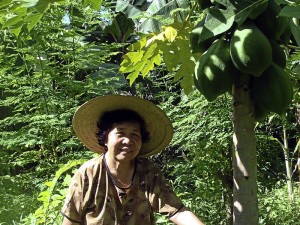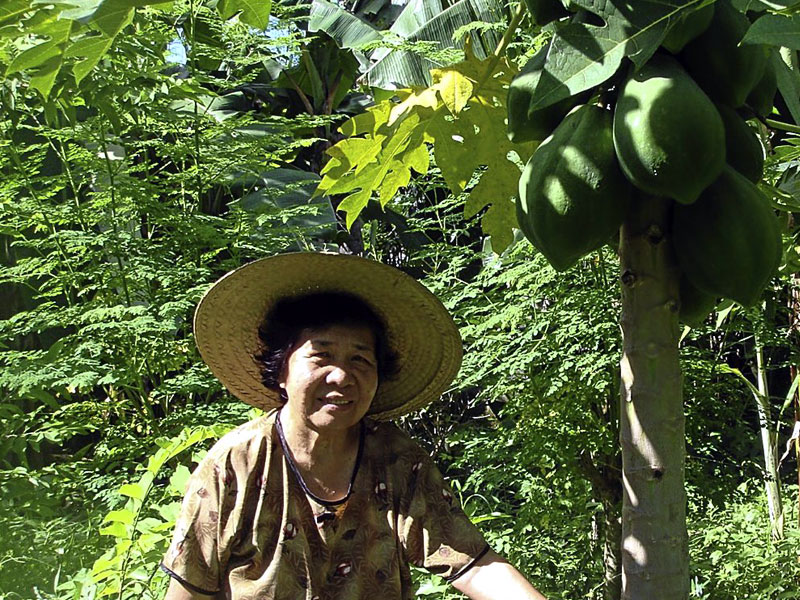
BAY, Laguna—“I started from nothing.”
So says Lourdes Redoloza of how she began her eight-year passion for gardening, a hobby that has proven fruitful, if only to remind herself that God rewards those who toil and till the land.
The former Physics professor from the University of the Philippines at Los Baños started tending her 2,000-sqm lot in Barangay (village) Puypuy, Bay town in Laguna full time after her retirement. She planted just about anything and sowed seeds and saplings of such trees as mahogany, narra, bamboo, guyabano, papaya, plantain bananas and calamansi. Later, she added ornamental plants like orchids and bromeliads, and cultivated vegetables and herbs, among them stevia, a healthy sugar alternative, “damong maria” that makes for a delicious tea drink and a plant called “choles,” said to reduce cholesterol levels.
Redoloza has learned to be philosophical about the country’s typhoons that regularly ravage her crops: plant anyway, she tells her friends; the strongest plants will survive.
Three years ago, supertyphoon “Milenyo” totally wrecked her garden and toppled her fruit trees, including 18 fruiting lanzones trees. “Ondoy,” “Pepeng” and “Santi” next destroyed her banana trees and brought down three spans of concrete fence. But in no time, she was planting again and the garden has started blooming anew.
“The floods and typhoons may have destroyed my fence and plants, but it also brought with it tons of garden soil that enriched my land,” she says.
Today, this hands-on backyard farmer has more than 50 calamansi plants, more than a dozen banana trees, six huge mahogany trees, dozens of papaya, guyabano, santol, atis, guava, jackfruit and other trees that are bearing fruits that her family shares at the dinner table. Redoloza knows the history of each plant, when and how she got them, how she propagated them, how they bloomed, reproduced and multiplied.
A visit to her garden one rainy day in June reveals that several clusters of plantain hang heavy and ready for the picking. She spots the ripest of the batch, and with a machete hacks at the banana trunk until it falls. She then gathers the bananas for serving to visitors and sets aside some for selling. She sells the bananas per piece to neighbors and friends at the farm gate price of 50 centavos, a far cry from the P2.50 to P3.50 apiece at the nearest public market.
When there are no buyers, she turns the plantains into banana chips or turon (fried bananas wrapped in rice paper) for her and her 8-year-old grandchild’s snack. She makes just enough, knowing that leftover chips could soon lose their crispness.
In May, as Redoloza was tidying up her garden, she found some yellow ginger or turmeric (luyang dilaw) in a spot where she had harvested several kilos a year ago. From a kilo of the root plant, she managed to produce half a kilo of ginger powder that could be brewed into tea powder. It takes several hours to peel and slice a kilo of ginger, she tells you, and another week to dry them. No wonder a kilo of turmeric powder is sold at P300 in the supermarket, she adds.
In mid-June, the papayas started ripening. Does she plan to make pickles (achara) out of the green ones? she is asked. She retorts: “The ingredients are expensive, and besides I can buy 10 pesos’ worth in the market, so why waste my time making achara?”
Like the bananas, the papayas grace the family table, with the rest of the harvest sold at farm gate prices, never mind if she doesn’t earn from them. She even allows walk-in buyers to harvest her Indian mangoes at contracted prices per tree, just enough to give her some cash to spend back on the garden.
Redoloza knows the market prices for her produce but is content with selling them at farm gate prices. Anyway, she shrugs, she had “no inputs” and merely planted and watered the malungay, the yams and sweet potatoes, the Indian mangoes and bananas. “It is in giving that we receive,” she says when asked about earnings from her small farm.
It is a problem of plenty that has benefited her friends and neighbors who continue to enjoy the fruits of her labor. In turn, they inform her of the latest trends in gardening, enrich her collection of herbs and ornamentals, teach her methods of producing organic fertilizer, or bring her to garden shows.
Gardening and backyard farming, Redoloza has realized, is a hobby that allows her to enjoy her retirement years while learning about herself and her relationships with nature. She has also learned about the art of sustainability, the joys of sharing, and the rewards of working the land.














































